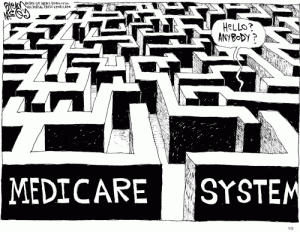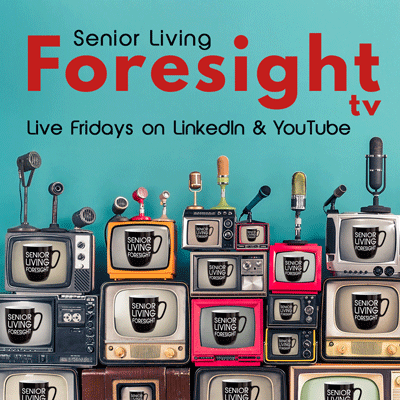By Jack Cumming
Exploding demographics promise senior living a bright, though elusive, future. True, the needs and anxieties of aging will continue. The question is whether the solution will be an institution defined by age limits and run by people who don’t live there. Alternatives to today’s senior living are coming fast. Will prospects view senior living as “community” living the way many in the industry do?
You may be thinking that senior living is by definition “community” living. There’s a fascination with words among those who deal with old people. Most recently, the question has been, “Is ‘Active Adult’ an Ageist Term?” We’ve seen the industry struggle with “senior”, “continuing care”, “retirement”, and more. The word “community” seems to be the only one that has sufficient patina to have survived all the rebranding burnishing that has tainted other words.
While senior living has co-opted the word “community” for its residences, for most people, community refers to the geographic neighborhood in which they live. It’s where they feel they belong. Beyond that, there are metaphorical usages as in “faith community”, “social community”, and more. It’s different, though, when senior living uses the word. Since such communities are typically owned and run by people who are not residents, they are more analogous to a company town. The classic company town is, say, a mine where a corporation provides living quarters. Communities are self-governed. Company towns house workers. Facilities house dependent people.
Staying Put
Within senior living, there is a growing conversation that people prefer to remain living at large as citizens until there is no alternative. For most people, that choice to stay put is more affordable than the alternative of moving to a “retirement community” whether it is called a “life plan community”, “continuing care retirement community”, “assisted living”, “memory care”, or most intense of all, a “skilled nursing facility.”
Thus, from a sheer value and money perspective, it’s wise to stay put or to downsize within the larger “municipal community” of ordinary citizens. It’s also wise from the perspective of individual independence since moving into a “retirement facility” involves a level of dependence on the decisions and changing priorities of the owners and the management. Senior living offers the mutuality of congregate living with people over a certain age, and with the promise of assistance should the need arise, sometimes at no material added cost, though increasingly provider contracts escalate costs as needs increase. That’s the reality as it now exists.
The Aging of Senior Living
As the senior living industry has moved toward older and older entry ages, meaning more age-afflicted residents, and with fewer included bundled care services, alternatives are beginning to arise. Perhaps, most visible, is the widespread availability of Senior Centers to meet social and congregate needs. Many Senior Centers have morphed into Community Centers allowing the mixed generation encounters that have eluded the senior living industry. Senior centers don’t do a good job with those who are confined to home by mobility or other issues, but otherwise, they are excellent.
Not only are Senior Centers vying with senior living, technology is also gaining ground to meet the needs of people who live dispersed. The attraction of senior living is reducing just as it is becoming more costly with less care included in the price. The latest technology wave began with Uber and Lyft since previously transportation was a major senior living attraction. At the same time, Uber and Lyft gave impetus to the new labor freedom made possible by the app-driven “gig” economy.
The Rise of At Home Technology
People like Seth Sternberg saw the opportunity to extend those gig economy concepts to assistance with activities of daily living. His data-driven approach addressed the challenges of trusting remote caregivers and assuring quality of care delivery. The partnership between Sternberg’s Honor business and Home Instead signals a new era for home-based assisted living . . . up to a point.
We will still need facilities for those with advanced dementia, high-acuity physical needs, and hospice qualifiers. Still, that narrow corridor of care services near life’s end is not how senior living likes to see itself. There’ll always be a market for Brookdale and others to meet these end-of-life needs.
If Only They Knew
A close observer of senior living learns quickly how misunderstood many of those working in the industry believe they are. It’s common to hear people say, “We just need to step up our storytelling,” or “If people just knew how wonderful senior living is, we wouldn’t have to work so hard to sell our services.”
What tells a different tale, though, is that most of these people are not planning to move into senior living themselves any time soon. Moreover, people working in senior living are, for the most part, assertive independent people, and they aren’t about to give up their independence to live in a community run by people who don’t live there.
Imagine The Future
What then is the future? For a moment, imagine a conventional “community,” perhaps the one you grew up in. It might be a small town, or a multi-family living community (cooperative, condominium, or rental), or it might be no more than an amorphous neighborhood. As a child, you probably knew some old people as neighbors. People age naturally in such communities.
In the ideal, such a community of neighbors is pedestrian-friendly with sidewalk-bordered streets so that older people and schoolchildren can move about safely. What happens, though, if some community members age and need services?
Meet Mary Jones, RN.
Those aging community members are there now, and in very few years there’s going to be a lot more. We’re beginning to return to accepting aging as a natural part of life. Here, for the sake of generality, we’ll fictionalize possible responses to that growing need for services. Mary Jones, RN, is tired of working shifts at the hospital with nothing to show for it but employment. She decides to start her own business providing services to those of her neighbors who need minimum help. When she’s retained by older people or by their families, she jumps in immediately to assess the challenges and help do whatever it takes so people are safe where they are and don’t have to move.
Joe and Sally Fischer are among Mary’s clients. Their house needs a new roof, but they just don’t have energy anymore to get it done. Mary works with them to find a roofer and to help them get what they need. Sure, she’s an RN, and care for the ailing is her professional calling. But she’s also a human being and she knows her clients. For Mary, her clients are like family. She makes sure they have what they need.
Residential Assistance
With time, Mary’s business grows. She brings in other people to work with her to serve her growing client base. Her first step is to qualify herself as a geriatric nurse practitioner, since she sees that is where the need is. She also retains a geriatrician on call to provide those services that require a physician’s license. Because her business is a relationship business, she knows her clients’ wishes. She also understands how their needs are evolving. She’s able to humanize aging much more than any facility can. Working for Mary is a calling, not a low-income job.
Mary’s next step only seems natural. Her clients are aging. So is Mary, but that’s another story. They’re aging together and there’s a mutuality and understanding in that common experience. With time, some of her clients develop challenges requiring closer supervision than can be provided with frequent visits and remote video-connection capabilities. Mary brings in a partner, a younger nurse whom she mentored during her years at the hospital, to establish a Residential Assisted Living Facility.
Mary’s new Residential Assisted Living Facility fits naturally into the neighborhood community in which Mary and her clients have lived all along. At first, she just takes possession of a large house in the neighborhood. In Mary’s case, she initially leases the house, though she might have bought it. Mary decided that she didn’t want the real estate headache of owning the property.
Multifamily Housing Industry
Nearby, there’s an attractive multi-story apartment building with elevators. It’s near the village center, and some of Mary’s clients want to move there as they grow older to avoid the hassles of homeownership. The apartment building has morphed into a naturally occurring retirement community, so Mary sees a need there as well for another Residential Assisted Living Facility. Mary works with the Condominium Board of the apartment building to buy two adjoining large apartments, and she finds another younger nurse to move in to provide the services needed for the new Residential Assisted Living Facility.
As noted, this is a fictional account, but it’s happening in the real world, and it’s likely to accelerate as people grow more and more resistant to institutional living, and as they seek a more normal path toward living full lives as they age. All around these age-related evolutions, the normal life of marriage, families, coming of age, and neighbors continues. Those who are aging are simply part of the larger neighborhood where people are citizens and where they know they belong and feel comfortable.
Doesn’t This Feel Natural?
What’s astounding is how natural this all feels. What’s also astounding is how this brings down the cost of aging. The natural evolution of aging brings normality back to the process. Older people are accepted as functioning, thinking contributors to the larger community without the shield of facility walls, fences, and gates.
Is community the future of senior living? Will ageism fall of its own weight if we build cities and towns that are pedestrian-friendly and welcoming of all people of all ages? Does today’s age-demarcated community – active living or care “community” – foster ageism? If so, restoring the natural approach to aging may help bring about its end. The boomer generation rightly expects no less. I call it “Better Living.” Is Better Living Senior Living’s future?
To learn how simple it is to get started with a Residential Assisted Living Facility click here for one account, here for another, and here for a third. There is considerable interest in this emerging alternative to facility living. Let us hear from you as to whether you think this change is possible. How might the established industry respond? How would change impact developers, financiers, accountants, operators, and regulators?








